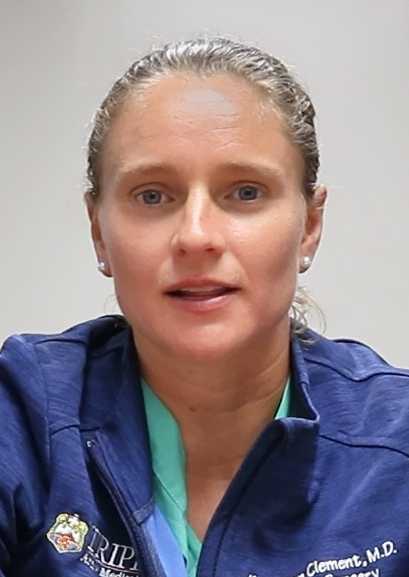Small Bowel Obstruction Following Robotic Transabdominal Preperitoneal Ventral Hernia Repair (rTAPP) Due to Barbed Suture
Transcription
CHAPTER 1
Hello, my name is Kathleen Clement, and I am one of the general surgeons at Tripler Army Medical Center in Honolulu, Hawaii. I'm going to present a case of a 29-year-old man who presented to our clinic with an incarcerated umbilical hernia with fat. The fascial defect measured approximately 1.5 cm. His past surgical history was notable for an open appendectomy as a child. We discussed options for repair for an open umbilical hernia repair with mesh versus a robotic repair, and he elected to undergo an elective robotic transabdominal preperitoneal ventral hernia repair. We took him to the OR in standard procedure, we placed a Veress needle to insulate his abdomen. We docked the robot on the left side of the patient's abdomen. We did our dissection. We reduced the fat in the ventral hernia. We repaired the fascial defect with an 0 absorbable barbed suture, and then we also closed the peritoneal flap with a 2-0 absorbable barbed suture called the V-Loc suture. During the dissection, which was notable because we made a small peritoneal rent that was also repaired with another separate 2-0 absorbable barbed suture. The patient did well, went home the same day. Unfortunately, the patient presented on post-op day two with an acute bowel obstruction with nausea, vomiting, and abdominal pain. He underwent a CT scan, which showed a small bowel obstruction with a transition point very close to where we repaired that peritoneal rent. He was managed overnight with NPO NG tube and actually improved overnight. Had bowel movement in the morning and was doing great. But given the location of the obstruction that was close to the peritoneal rent that we repaired, we were concerned that maybe there was a issue with the closure of that peritoneal defect. So we recommended we take the patient back to the operating room for a diagnostic laparoscopy to evaluate what occurred. I'm also gonna introduce Dr. Keaton Altom, who's one of my general surgery residents who's involved in this case, and he will discuss the rest of the case with you.
CHAPTER 2
So this was our view whenever we inserted the laparoscopic camera and instruments into the same port sites that we had used for our initial operation. We quickly identified that there was a strand of barbed suture hanging down from the anterior abdominal wall. And it was intertwined in the bowel mesentery, essentially in the groove between the bowel serosa and the bowel mesentery, suspending the bowel anteriorly.
CHAPTER 3
So we grabbed the barbed suture and then carefully began to tease out the bowel mesentery away from it. In the background, you can see adhesions from his appendectomy as a child.
CHAPTER 4
Here we're inspecting our peritoneal flap closure from the initial operation to make sure there's no exposed suture. Here we're just taking a closer look at where the barbed suture is coming from, which appears to be the right lateral side of the patient's hernia defect - the same location that the peritoneal defect was made and repaired with the barbed suture. And it appears that the end of the barbed suture that we had ran back two throws had pulled through.
CHAPTER 5
Here we're just taking a closer look at where the suture was intertwined in the mesentery. Overall, it looks okay. The valve just looks a little bit irritated.
CHAPTER 6
Here we are inserting laparoscopic scissors. Then we simply cut and remove the suture that was hanging from the peritoneum.
CHAPTER 7
Here we are taking a look at the rest of the abdomen. And another look at our peritoneal flap closure.
CHAPTER 8
So at this time, the patient is now over a month post-op with no further complications. To summarize, this was a 29-year-old male that presented initially with a fat-containing umbilical hernia and underwent an elective robotic transabdominal preperitoneal hernia repair that was uncomplicated, but the patient re-presented on post update two with a small bowel obstruction caused by a barbed suture that had come loose and intertwined in the bowel mesentery. The patient had very thin peritoneum on our initial surgery, which unfortunately led to us creating a rent in that peritoneum. So we proceeded as usual, repairing that rent with the barbed suture, running it closed, and then also once the rent had been repaired, running the barbed suture back a few throws to make sure that it was secured in place. At the time of the case completion, there was no exposed barbed suture that we saw, and so we concluded the case. Barbed suture is overall a very great asset to modern surgeons. It's an efficient suture. It reduces operative time. It reduces blood loss, increases tensile strength by spreading out the strength of the suture throughout its length rather than typical suture where a lot of the tensile strength is all in the knot at the end of the suture. It also reduces surrounding inflammation and local tissue hypoxia by reducing the amount of constraint on the tissue around the suture. It's been around since the 1950s, but has become ever increasingly popular with the advent of modern robotic surgery in the late 90s and early 2000s. Despite all the benefits with barbed suture, there have been a handful of complications over the past few years, including small bowel obstruction. There's not a lot of data published on these complications yet, but one recent large literature review looking at general surgery cases from 2011 to 2020 revealed a handful of cases that presented with small bowel obstruction caused by barbed suture. These patients often presented within a week to two weeks after their initial operation, but some presented several months after the index operation. There's a few things that surgeons can do to reduce these incidences, these complications. First of all, once you complete running the barbed suture, you should run it back a few throws to make sure it secures into place. Only use barbed sutures where it's not gonna be exposed to intra-abdominal contents, and if it is, consider using a different form of absorbable suture. After you do run the suture back a few throws, you can cut the tail off. Try not to cut it too short where it's gonna pull through, but you also don't want it so long that it's hanging out into the abdomen. And then if there is exposed barbed suture, which is often seen in in specific surgeries such as ob/gyn, surgery on the uterus, you can apply a barrier device to help try to shield that barbed suture from the intra-abdominal contents. Ultimately, when this complication occurs, it needs to be investigated promptly and often only requires removing the exposed suture.


